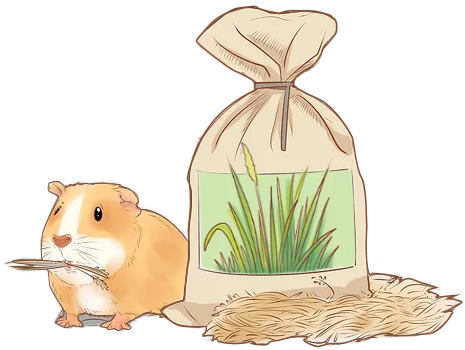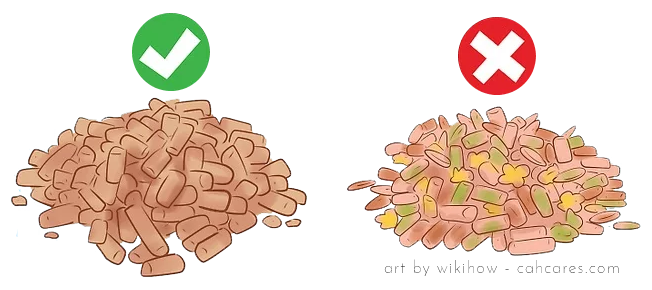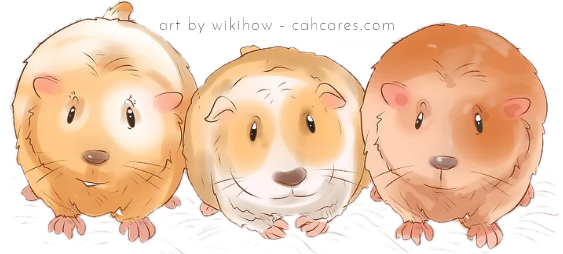Guinea Pig Care and Husbandry
adapted from "The Small Mammal Health Series" by Susan Brown, DVM and "Guinea Pigs as Pets" by Deborah Monks, BVSc, FANZCVS, ECZM.
The guinea pig or cavy is a docile rodent first domesticated by the Andean Indians of Peru who used them as a food source, and were first domesticated as pets by Dutch explorers in the 16th century. A long and healthy life hinges on the care and diet we provide as pet owners.
Let's talk diet.
Generally, an adult guinea pig with a medium level of exercise would get no more then ¼ cup of pellets a day, along with unlimited grass hay and a small amount of fresh foods to cover Vitamin C supplementation.
|
The most important part of a guinea pig’s diet is good quality grass hay, available all the time.
|
Guinea pig teeth grow throughout life, and their molars are made to grind up tough fiber. You can use any grass hay, including timothy, orchard grass brome and others.
Oxbow or Mazuri brands are recommended choices, and can be purchased in most pet stores, or online through sites like chewy.com. Avoid the use of alfalfa after 6 months old, which is not a grass but rather a legume (like peas and beans) and is generally too high in calories and calcium (which can lead to a tubby little pig). The hay can be provided in a hay feeder or put in the corner of the cage. Even better, put it in an “edible” basket or cardboard box for more fun! |
Many pet store guinea pigs have been fed nothing but pellets, and may be hesitant to try new foods. Read the label and use a brand that is grass-hay based. Stick to pellets that look plain and have a consistent appearance - fiesta mixes with several different colors and shapes are designed to catch your eye, but high quality is key.
Fresh, clean water should always be available in a heavy crock that prevents spillage. Guinea pigs like to play with their water bottles, so make sure you check the bedding under the bottle for moisture and change it frequently. Do not add vitamins to the water as it will change the taste, and your guinea pig may not drink as much.
Vitamin C Supplementation
Guinea pigs do not produce their own vitamin C. They share this quality with us humans and primates. They need an outside source of vitamin C in order to avoid developing a serious medical condition called scurvy. Fortunately it is pretty easy to provide your guinea pig with vitamin C by giving some fresh vegetables daily, particularly dark leafy greens such as kale, collard greens, mustard greens or dandelion greens. One-quarter cup (packed) of any of these greens will provide more then enough vitamin C daily. Other fruits or vegetables that you might want to try include sweet peppers, apples, pears, berries, broccoli, cucumbers, parsley and basil. The total amount of fresh foods given in a day should be around ¼ to ½ cup. When testing out new fresh foods, add one every 3 to 4 days to give a fair trial to see if the guinea pig will eat it.
Excellent Sources of Vitamin C
|
Fair/Poor Sources of Vitamin C
|
If supplementing Vitamin C, we strongly recommend a quality treat over any water additives. A great source are Oxbow's Vitamin C biscuits, which are also readily available online.
Cages and Enrichment
There is no single correct way to house your guinea pig, as long as the well-being of your pet is considered. It is important that the flooring is solid (no wire mesh!) but not abrasive, with good ventilation on the sides and top. Although solid flooring requires more effort to keep sanitary, it is safer for the guinea pig. Bedding materials must be clean, non-toxic, absorbent, and easy to replace. We prefer clean, frequently-replaced fleece or paper bedding. Avoid cedar shavings and saw dust, as both are associated with problems.
The size of the enclosure should allow for normal guinea pig activity. At least 100 square inches of floor area per guinea pig is recommended. The enclosure can remain opened on the top if the sides are at least 12" high (as long as other family pets such as dogs or cats are not a threat). Since they are active at night (nocturnal), guinea pigs require quiet periods of light in order to rest.
The size of the enclosure should allow for normal guinea pig activity. At least 100 square inches of floor area per guinea pig is recommended. The enclosure can remain opened on the top if the sides are at least 12" high (as long as other family pets such as dogs or cats are not a threat). Since they are active at night (nocturnal), guinea pigs require quiet periods of light in order to rest.
Guinea pigs are social, and derive comfort from leaning against each other; this is called being thigmotactic.
Guinea pigs should therefore be kept in same sex groups of at least two. Pigs kept together since youth are likely to live harmoniously, however, guinea pig relationships can deteriorate and sometimes previously harmonious animals may need to be separated.
Providing more then just a bowl of pellets every day is another step towards making your pet more content at home with you. Try putting the hay or fresh food in places such as hidden in little crumpled bits of paper, empty toilet paper or sections of paper towel rolls or non-toxic baskets just for fun! Putting the pellets in a small hollow plastic ball with small holes drilled in the side that are slightly larger then a pellet is another great way to keep their minds engaged.
Providing more then just a bowl of pellets every day is another step towards making your pet more content at home with you. Try putting the hay or fresh food in places such as hidden in little crumpled bits of paper, empty toilet paper or sections of paper towel rolls or non-toxic baskets just for fun! Putting the pellets in a small hollow plastic ball with small holes drilled in the side that are slightly larger then a pellet is another great way to keep their minds engaged.
How to Medicate or Syringe Feed a Guinea Pig
You may have been prescribed medications or syringe feeding for your guinea pig as part of a treatment plan. Frequent feeding and timely administration of treatments are essential for recovery. The below video shows some helpful tips for how to do these things safely.


